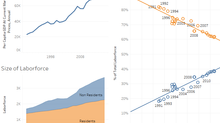Beyond Numbers: Unraveling the Art of Data Storytelling

Introduction: What is Data Storytelling?
Imagine a healthcare company that used data storytelling to uncover hidden patterns in patient recovery times, leading to improved treatment plans and better patient outcomes. This example underscores the power of data storytelling—an art form that blends data insight with narrative and visual elements to make complex information accessible and compelling.
Unlike mere data presentation, storytelling involves a narrative arc that contextualizes data, making it relatable and actionable. This method serves to bridge the gap between raw data and strategic decision-making, engaging the audience with a storyline that highlights critical insights and guides them towards informed actions.
Purpose of Data Storytelling
The primary purpose of data storytelling is to influence decision-making by presenting data in a context that resonates with stakeholders. It's about weaving facts into a narrative that underscores the relevance of data insights to the business or operational goals. Effective storytelling translates statistical outputs into stories that inspire, persuade, and drive change.
Distinguishing What Data Storytelling Is Not
1. Descriptive Commentary
While describing what the data shows is a good start, true data storytelling delves deeper. It explains why changes occur and what the implications are, moving beyond mere observation to provide analysis and foresight. For instance, when a sudden drop in sales is presented without explanation, it's merely descriptive. True storytelling would explore and explain potential causes, such as market shifts or operational changes, enhancing understanding and driving strategic decisions.
2. Added Context Alone
Merely adding context to data does not constitute a story. Data storytelling requires a structured narrative that connects the dots between data points to reveal a comprehensive picture, often driving towards a strategic conclusion or recommendation. Consider the impact of a startup that used data storytelling to secure funding by not only presenting user growth metrics but also narrating the journey of user engagement strategies and their evolution over time.
3. Reliance on Data Charts
Charts and graphs are indispensable tools that support data storytelling by visualizing information, but they are not stories in themselves. A narrative that explains the connections, trends, and anomalies within these charts is essential for true storytelling. This narrative should guide the audience through the data, highlighting its relevance and the decisions it can inform, such as a company deciding to expand into new markets based on growth trends visualized in their sales data charts.
4. Equating Visualizations with Storytelling
Good visualizations are crucial, but they are just one part of data storytelling. Effective stories are those that incorporate visualizations as narrative tools that help illustrate and support the storyline, not replace it. These visual aids should enhance the narrative, making the data more understandable and impactful, rather than serving as standalone elements.
5. Dashboards as Stories
Dashboards are instrumental for ongoing monitoring and can highlight important data points or trends, but they lack the narrative structure required for storytelling. They provide data snapshots, not the narrative needed to drive action. While dashboards are useful for data exploration, they do not replace the need for data stories that articulate a clear message or action plan.
Conclusion: Embracing Authentic Data Storytelling
Understanding what data storytelling is not helps in crafting messages that are not only informative but also transformational. True data storytelling elevates mere data into memorable narratives that inform strategic decisions and provoke thoughtful action. As we continue to evolve in our data-driven world, let’s strive for narratives that not only present data but transform it into an insightful story that drives real-world impact. Start today by reassessing how you present data within your organization and commit to developing narratives that not only inform but also inspire and engage.
This comprehensive revision aims to clarify the essence of data storytelling, dispel common misconceptions, and highlight its importance in strategic decision-making, making it an essential read for anyone looking to leverage data in meaningful ways.

























Comments